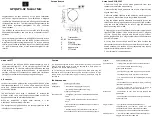
30
4.4. Audio design
This section describes the design for connecting MAS-A100 units to the system.
MAS-A100 audio output overview
The MAS-A100 functions as a Dante transmitter device with two channels of audio
outputs (Main output and Rec output) on a Dante network. Design how to route the
separate outputs to the speech reinforcement system and recording system,
respectively.
A wide range of Dante peripherals are available, from simple D/A converters and
Dante-compatible DSPs through to Dante receiver software. The MAS-A100 supports
the Dante audio network and is compatible with these products.
Routing
Routing of Dante signals for Dante receivers within the same segment (same layer 2
network) is used to transfer audio.
Dante Controller and Dante-compatible DSPs are used to configure Dante devices and
route audio between Dante devices. For details, see “5.4 Routing of Dante audio”
(page 59) and refer to the Dante Controller user guide or the operating instructions for
the Dante-compatible DSP.
Transmission method
There are two kinds of “flows,” which are the units of transmission for audio data on a
Dante network. One is a unicast flow, where a Dante device transmits a flow directly
to another Dante device. The other is a multicast flow, where a Dante device transmits
a flow to multiple Dante devices within a network. By default, flows are unicast. It is
not necessary to change this usually. Each unicast flow can contain up to four audio
channels.
The following diagram shows an example of one unicast flow, where the MAS-A100
sends the Main output and the Rec output to the Dante receiver of the DSP mixer.
Then, the Main output passes through the speech reinforcement system, and the Rec
output passes through the recording system, respectively.
















































